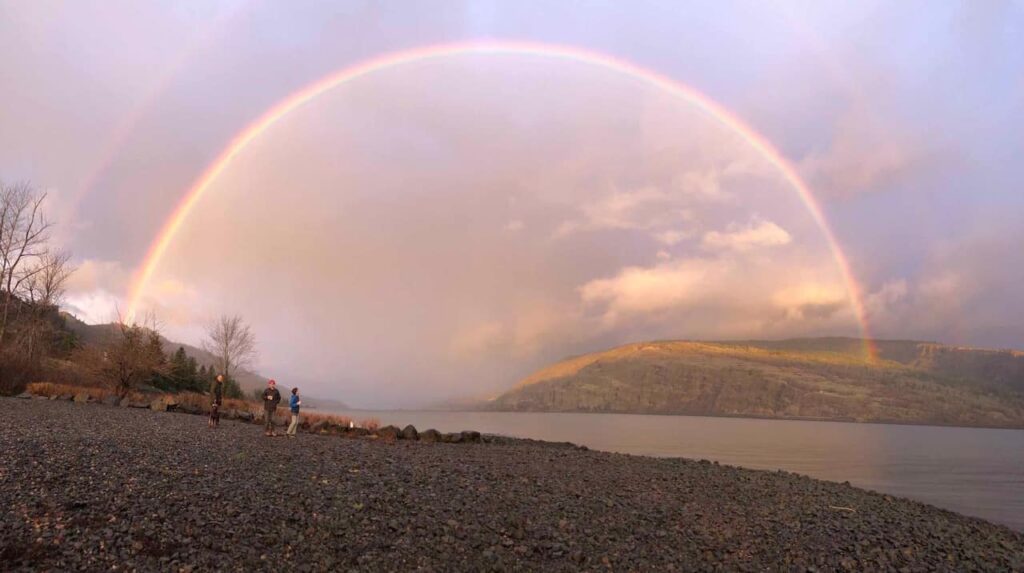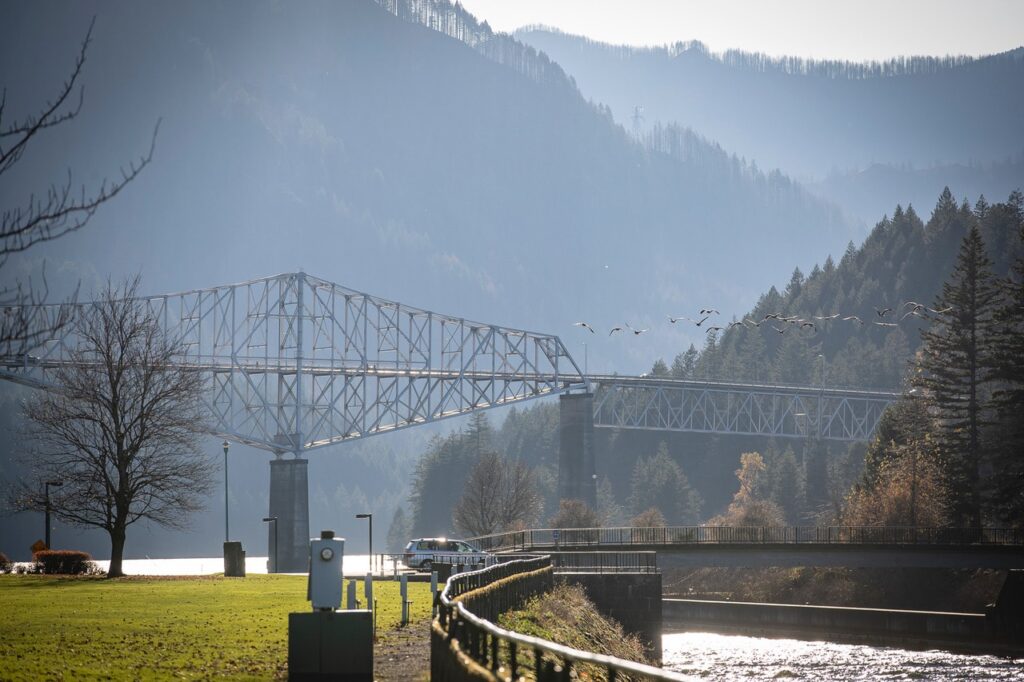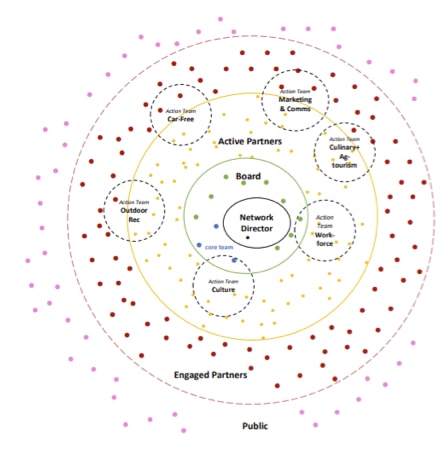
The Search for Holistic Destination Management In our last DSR issue, we discussed the importance of GSTC Destination Criterion A1, which reads in part: “The destination has an effective organization, department, group, or committee responsible for a coordinated approach to sustainable tourism, . . . for the management of environmental, economic, social, and cultural issues.” The requirement seems obvious, yet surprisingly few places around the world come even remotely close to meeting it. Below is Jacqueline Harper’s profile of one that does, fourth in a series of such profiles being assembled by the Destination Stewardship Center.
Columbia Gorge Tourism Alliance, Oregon and Washington States, USA
The mission of the Columbia Gorge Tourism Alliance (CGTA) commits to “developing the region as a world-class sustainable tourism economy”. This non-profit organization works both to protect and enhance the scenic, natural, cultural, and recreational resources of the Columbia River Gorge and to highlight lesser-known local communities.
The Columbia River Gorge became a National Scenic Area when President Ronald Reagan signed an Act on November 17, 1986. The Columbia River Gorge Visitors Association (CRVGA) was founded in 1990 as a bi-state initiative to promote the gorge to the tourism industry. Thanks to the Gorge Tourism Studio conducted in 2016, over 250 stakeholders – ranging from public agencies to private enterprise and community leaders to youth – came together to discuss ways the local communities could be economically stimulated through sustainable tourism while at the same time protecting the local environment. Thus, the CRVGA grew into the CGTA.
The Gorge Tourism Studio is a program developed by Travel Oregon that addresses and collaboratively solves critical issues in the region such as balancing economic benefits of tourism with preserving quality of life, natural resources, and cultural resources.

Geographic description
The CGTA is exemplary as it brings together a bi-state area, representing both Oregon and Washington. The Columbia River, the basis for the Scenic Area, forms a natural state border between Oregon and Washington State. The CGTA includes the National Scenic Area (see map below), reaching from the Sandy River to the Deschutes River (both on the South side of the river) and from Mt. Adams (WA) to Mt. Hood (OR). It is the largest National Scenic Area in the United States. Not only does it cover two states, but it also brings together six counties, and 15 towns, encompassing over 292,500 acres. The Gorge canyon at its core consists of both rain forest and desert. The canyon is 80 miles long and up to 4,000 feet deep. Many visitors travel here for a world-class adventure experience as this region has many scenic trails, rivers, cascades, and mountains. This destination is sought after by windsurfers, kiteboarders, and sailors for the “nuclear winds” created as the rainforest transitions into the desert, according to the CGTA.

Context
To the CGTA, sustainability is about optimizing positive impacts of the visitor economy while protecting the land. “Tourism is a sustainable economic driver to protect these [natural] areas and respect them,” says Emily Reed, Network Director of the CGTA.
The Gorge Tourism Studio had another legacy; the event brought stakeholders together where they created a vision to shape the region over 15 years. By 2031, as a part of the 15-Year Vision for Sustainable Tourism, the CGTA wants to achieve objectives in the following areas: transportation, culinary/agriculture, culture, seasonality/congestion, and balance. For transportation, the region would like to be connected by a transportation system that allows visitors to come travel and explore the region without needing a car. In terms of agriculture, they want visitors and locals to eat what is grown and produced in the area in addition to alleviating hunger in the region. The CGTA wants to spread the knowledge of the local culture, so tour guides teach about it and food trails of national significance are marked. Another key factor is to make tourist hot-spots less congested and spread the benefits to less popular areas of the region and times of year. Finally, the CTGA wants to create a visitor experience that balances protecting the local communities, culture, and natural environment.
Under the CGTA’s Statement of Intent, their strategies for being a sustainable world-class destination are to:
- Spread the seasonality of visitation
- Reduce congestion during peak seasons and in high-use areas
- Spread the benefit and increase the economic impact of tourism throughout the entire gorge
- Respectfully and authentically integrate cultural heritage into the visitor experience
- Connect resources to optimize destination marketing
- Capitalize upon the visionary projects underway in the Gorge to ensure this place remains a world-class destination
While the 15-Year Vision does not specifically mention enhancing the environment, Emily Reed, explains that the National Scenic Area defines everything the CGTA does. Tourism protects the natural area as it generates an economic benefit, showing that if tourism is managed correctly, it is a sustainable economic driver.
Organizational Structure and Governance
The CGTA is a network of diverse businesses and organizations. It consists of a Board and a Core Team (see the network diagram below). The Board typically has nine voting members and four non-voting advisors. The Core Team is chosen by the Board and is made up of three to five people, representing both Oregon and Washington, and has decision making power. At the center of everything is the Network Director. The Network Director convenes the network and supports the Action Teams under Board oversight.

The six different Action Teams have self-appointed leadership. To become a part of this project or get involved, network participants self-select themselves, based on expertise, interest, and capacity. The Marketing and Communication Action Team communicates about projects aimed at achieving the purpose of the network. The Car-Free Visitor Transportation Action Team is working on visitors traveling in the region without the need for a car. The Culture Action Team is focused on highlighting the history and unique stories of the Gorge and surrounding region. The other three Action Teams are culinary and agritourism, outdoor recreation, and workforce.
There are over 80 active and/or engaged participants. Active Partners collaborate and carry out the purpose of the network. Active Partners meet quarterly with the network to focus on tourism on both sides of the river. You can become a partner/renew your partnership by filling in a form and investing financial resources into the CGTA. Most Active Partners are also involved in Action Teams. Engaged Participants (businesses and individuals) take part in larger events and help with projects. A newsletter and social media keep the public up to date on projects.
Due to the geographical reach of the CGTA, coordination with the local and regional Destination Marketing Organizations is critical, and they are participants and partners in the Columbia Gorge Tourism Alliance.
Activities
Network participants have direct responsibility for protecting and sustaining the character of the Columbia River Gorge. The collaborative work aims to share the cultural and natural history of the Gorge with visitors and cultivate a sense of stewardship over time. Some of the projects the tourism alliance is working on include We Speak the Gorge, Hear in the Gorge, Ready Set Gorge, East Gorge Food Trail, and Columbia Gorge Car-Free.
We Speak the Gorge is a front-line training program so that workers can increase the awareness of visitor service and resources throughout the Gorge. This program was initiated by the Marketing and Communication Action Team. The goal is to have all front-line staff communicating a consistent message as well as highlighting top spots in each community to visitors. The idea is to serve the customers while growing the sense of community and strengthen bonds with neighbors.
A podcast series, called Hear in the Gorge, was developed by their Cultural Heritage Action Team. It communicates the cultural and natural history of the area while encouraging visitors to encounter the place and its people more thoughtfully, and with greater care. The podcast episodes dig into the stories of a place, listening to the people who know it best. You never quite know what to expect.
Sustainability and Stewardship Programs
The CGTA supports Ready, Set, GOrge, which is an educational initiative that develops messaging and visitor maps to guide sustainable and thoughtful visitation. The website promotes travelers to support the local communities by offering advice on planning your trip, preparing for your trip, and connecting with the community when on your trip. It also promotes tips for traveling with care in nature, such as how to prevent invasive species and leaving no trace.
Another program working to educate hikers is Trail Ambassadors, which places volunteers at popular trailheads in the Gorge. Volunteers engage with visitors around safety, ethical use of public lands, and Leave No Trace practices. They are also trained to help visitors engage with the local community. This program helps keep ecologically sensitive areas from being permanently damaged by tourism pressures.
The East Gorge Food Trail brings local organizations together to enhance and connect culinary and agricultural businesses to showcase the Gorge food system. Developed by the Culinary and Agritourism Action Team, the Food Trail links family-owned farms, farm-to-table experiences, crafted cider, wine, and beer, and everything in between. The trail is open throughout the year and can be toured car-free. The website provides examples of itineraries and outlines the best time of the year to travel for specific produce.

Managing Tourism Volume
Although the CGTA is not actively discouraging visitors to overcrowded places, they are promoting visits to lesser-known sites and businesses and making travel accessible by car-free transportation. The organization encourages visitors to well-trafficked areas to come during shoulder season or mid-week. Additionally, the CGTA promotes less frequented businesses and outdoor recreational activities that have capacity available, working alongside tour operators to guide visitors to less congested and lesser know locations and businesses.
To do that, the CGTA works with transit and public agencies to develop transit connectivity and develop car-free transportation options to trailheads and communities within the gorge. The CTGA’s Car-Free Visitor Transportation Action Team manages the Columbia Gorge Car-Free project, comprising a team of transportation professionals from private and public transportation providers, nonprofits, government agencies, and small businesses that offer the best options for exploring the Gorge car-free, whether by bus, foot, or bike. From the Columbia Gorge Express Performance Report Card, the Columbia Gorge Express was able to divert an estimated 20,700 vehicle trips from Multnomah Falls between 2016 to 2019. Columbia Gorge Car-Free also publishes example itineraries for car-free experiences, such as the Tasting Bike Rides of the Eastern Gorge.
Community Engagement
The CGTA works extensively with many different organizations in the area. The network includes, but is not limited to: the US Forest Service; Oregon and Washington Departments of Transportation; Oregon and Washington State Parks; planning departments; Columbia River Inter-Tribal Fish Commission; and cities and counties in this region. The network receives feedback from a diverse range of stakeholders. The Action Groups are designed to respond to this feedback and adapt it into their projects.

Tourism is an important economic factor in the region as it has created some 5,000 tourism jobs for the locals. Businesses play an important role in the tourism community. If a small business, nonprofit, agency, residents, or community group from the six involved counties is interested in stewarding sustainable tourism, they are welcome to attend bi-monthly meetings of the network’s active participants. They can also receive CGTA e-newsletters or participate in project teams. The CGTA is beginning to actively engage stakeholders that are not currently involved in the network – emergency services, elected officials, and residents. The tourism alliance deems it is important to engage perspectives, criticisms, and ideas from these stakeholders to ensure local quality of life is upheld. For stakeholder feedback, the CGTA has quarterly network meetings, where stakeholders attend and ask questions and participate in polls and break-out groups. Surveys are also used to touch base with stakeholders.
The CGTA hosts the Gorge Tourism Summit every two years, which brings together agency staff, small business owners and managers, and nonprofit leaders from across the Gorge to discuss trends, best practices, and network with like-minded businesses and people. The event is geared toward new and current network participants, residents, and industry partners. Along with the Gorge Tourism Summit, the CGTA also promotes events organized and hosted by their network Participants, such as guided hikes, planting native plants, and trivia nights. The CGTA network is keen to expand on organizing events as a way to partner with local and regional associations, organizations, businesses, and agencies.
Funding
The CGTA works with a small budget that is acquired from partner contributions, the annual Gorge Tourism Summit, and grant funding. Partnership investments are made by small businesses, nonprofit and destination marketing organization participants, and from cities and counties within the network’s jurisdiction. Typically, funding and resources are more available on the Oregon side of the border, where the Alliance has more community partnerships. Although the budget is small, it has been stable. High priority projects receive funding first. Other projects are allocated funds depending on what remains.
There are three partnership options and the cost of becoming a partner depends on business type, size, and revenue. The Full Partner option has three sub-levels: Private, Non-Profit, and Public Agency. Private Companies have a minimum investment of $250; Non-Profits have a minimum investment of $150, and Public Agencies have dues that range between $500 to $2,000 depending on the number of employees. The Sustaining Partner option requires an investment of $3,000, with the partner eligible to be featured in special promotions. Finally, Contributing Partners invest less than the Full Partner level but are expected to provide additional support for the CGTA. In return, the GCTA connects their partners with resources, helps partners find funding for their projects, and promotes their efforts and projects.
Funding has been impacted due to the COVID-19 pandemic, of course, but the CGTA is still operating and hosting virtual events and stakeholder meetings during the pandemic.
Measures of success
One important measure to get a full picture of the CGTA’s impact and progress relates to network building. Metrics include the number of participants regularly attending bimonthly meetings, numbers engaged in project teams, and the number of partners contributing financially. A second measure gauges the network’s impact, using metrics that include local quality of life, participation in public forums, transit ridership numbers, visitor numbers to lesser-known locations, seasonal visitation numbers in all regions, the reach of the podcast and visitor messaging, and social media and web impressions.
Two pieces of advice Emily Reed has for other destinations are:
- Diversity is key. You need to have as many different perspectives at the table as possible.
- Have a balance between meeting and doing. People cannot meet just to meet; you will not see progress that way. How fast you go, how much time you put in, and how much feedback you receive will determine your progress.
My commentary
CGTA has been challenged with the big task of working across fragmented geographical jurisdictions. However, with the emergence of this tourism alliance, I believe the effort to align multiple jurisdictions, communities, and DMOs is exactly what was needed for the Columbia River Gorge. By bringing together stakeholders from both sides of the river, it has allowed for management of this National Scenic Area to be a success. Many of the program’s’ websites reference one another to make finding information and resources for visitors to be seamless. It has turned the question from “which organization is responsible for managing which part of the scenic area?” into “how can we collectively make traveling to the Gorge as sustainable as possible?” This collective effort is why the CGTA was chosen as a destination stewardship role model for many other destinations that cross borders or jurisdictions.
The largest concern for the CGTA is distribution of funding for programs and projects across political boundaries. Travel Oregon is well established and has state funding, while the Washington DMO is still in its building stages. It is concerning that more funding and resources are available for projects and stewardship on the Oregon side at risk of neglecting the equally important Washington side. One recommendation may be to partner with businesses that do not have geographical constraints. If the CGTA is not having many partners sign up on the Washington side, they may need to reach out to local businesses that may not be aware of the benefits of joining the CGTA. Having sustainable funding is crucial for continuing the environmental and social progress the CGTA has achieved over the last four years.
The CGTA’s 15-Year Vision for Sustainable Tourism has initiated many great sustainability programs, such as Columbia Gorge Car-Free, Ready Set Gorge, and the East Gorge Food Trail. However, there is little communicated about the five areas of focus that are outlined under the 15-Year Vision. It would be helpful for stakeholders to see specific goals and targets for each area of focus. Moreover, there is no explanation for tracking metrics or progress of the focus areas. For example, it appears that the CGTA values quality of life for the locals, however, there are no publicly communicated metrics for engaging with locals to ensure that no voice or group is left unheard. Without clear direction, stakeholders are left wondering what exactly the end vision is for 2031 and how the CGTA is staying on track. Additionally, there is no sustainability leader within the CGTA to help ensure the goals and targets are on track across all the areas of focus and Action Teams to achieve the 15-Year Vision.
We welcome your comments on the Columbia Gorge Tourism Alliance and its stewardship.
Jacqueline Elizabeth Harper is a student at the University of Waterloo, Ontario, Canada.

